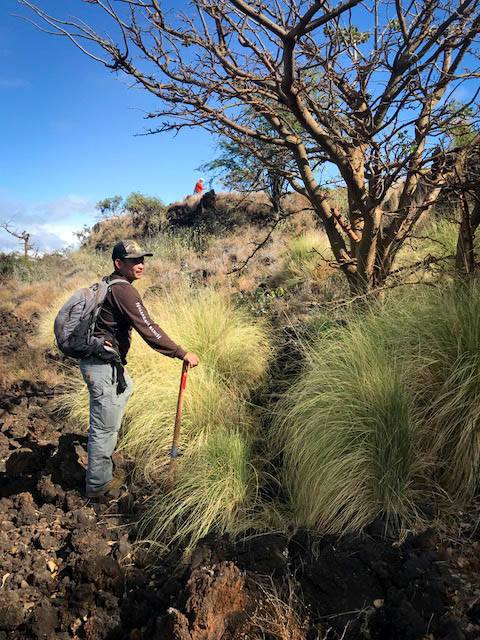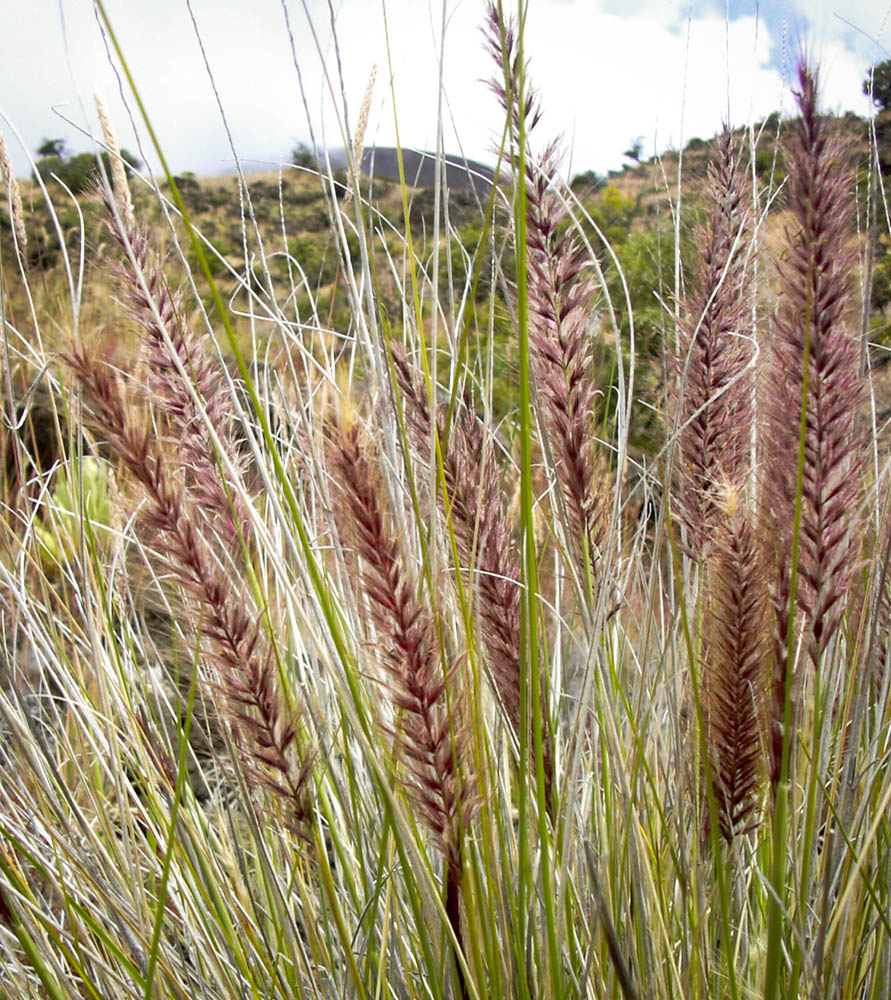
On the leeward slope of Haleakalā above Kīhei rises a red dirt cinder cone named Puʻuokali. Puʻuokali means “the hill of waiting,” and is said to be one of several mo‘o (lizard deities) who were transformed into cinder cones on the summit. From her prominent vantage, Puʻuokali watches over her daughter, Puʻuoinaina on the island of Kahoʻolawe. As visible as Puʻuokali is to Maui residents, she also has her secrets. Inside the cinder cone is an intact dryland forest – a representation of the most diverse and most threatened ecosystem in Hawaiʻi. This native oasis was forgotten about until the early 1980’s when a brush fire broke out nearby and biologists rediscovered the forest.
Dr. Art Medeiros, program manager for the Auwahi Forest Restoration Project, was one of those biologists. “Puʻuokali is amazing. It’s almost the only place from Makawao to Kaupō that looks like it did when Hawaiians were the only people here.” Wiliwili, lama, naio, koaiʻa, and ʻohe are the dominant trees of this forest – these plants were essential for early Polynesians but are virtually unknown today. Dryland Hawaiian forests are the most diverse of Hawaiian forests, yet they are virtually lost: an estimated 90 to 95% of dryland forest is gone. What remains is critical: 25% of endangered Hawaiian plant species are found in these tiny refugia.
In July of 2018, Byron Stevens of the Hawaiʻi Natural Area Reserves System passed over Puʻuokali in a helicopter and saw something that didn’t belong: a two- to four-foot-tall bunchgrass with wiry leaves and purple bottle-brush flowers. Fountain grass. He sounded the alarm to multiple conservation organizations.

Fountain grass is an invasive weed rarely found on Maui. Native to North Africa, it’s targeted for eradication by the Maui Invasive Species Committee. The drought-tolerant grass is able to survive in some of Hawaiʻi’s driest areas; it poses a serious threat to native dryland forest. While rare on Maui, the alien grass now covers much of the leeward coast of Hawaiʻi Island. Introduced as an ornamental in the early 1900s, fountain grass has completely transformed the Kona side of Hawaiʻi Island, turning what was once bare lava with patches of native forest into fields of grass.
“Introduced as an ornamental in the early 1900s, fountain grass has completely transformed the Kona side of Hawaiʻi Island, turning what was once bare lava with patches of native forest into fields of grass.”
Dominating arid, bare lava is one thing, but this wiry bunchgrass can also advance into intact forest, in part because it survives brushfires. Fountain grass is fire-adapted; it can regrow after flames pass over then quickly flowers and set seeds to recolonize the area. In contrast, Hawaiian forests are not adapted to fires—native plants generally donʻt survive. Fountain grass is notorious for fueling and increasing fire. At one site on Hawaiʻi Island, fountain grass (ignited by humans) has increased fire frequency from once every 500-1,000 years to once every 6-8 years.
“Fountain grass is a direct threat to the Maui County sanctuary forests such as Puʻuokali, says Medeiros. Though surrounding areas have burned, Puʻuokali has not had any wildfire, hence why so much remains. This hidden forest survived over the years partly because the surrounding landscape was so barren. There was no fuel for brushfires, and less incentive for goats and deer to cross the cinder to reach the crater. “The last refuges [of dryland forest] are in these rocky areas,” Medeiros explains. The intrusion of fountain grass changes that.

With that in mind, crews from multiple organizations – Auwahi Restoration Group, Haleakalā Ranch, the Maui Invasive Species Committee, and the Plant Extinction Prevention Program – came together to remove over 1,000 fountain grass plants from Puʻuokali. Completing the work will take several years. Grass seeds cover the ground and recent rains will bring a flush of seedlings. But now that the infestation has been detected, it can be managed and eradicated.
You can help. Fountain grass is often used as an ornamental landscaping plant, and people sometimes plant it on Maui by accident. Seeds can be unwittingly transported interisland on hunting or golf gear. If you see fountain grass, take a photo and report it. You can contact MISC directly at 573-MISC (6471) or the statewide pest hotline at 643-PEST, or 643PEST.org.
Lissa Strohecker is the public relations and education specialist for the Maui Invasive Species Committee. She holds a biological sciences degree from Montana State University. Kia’i Moku, “Guarding the Island,” is prepared by the Maui Invasive Species Committee to provide information on protecting the island from invasive plants and animals that can threaten the island’s environment, economy, and quality of life.
This article was originally published in the Maui News on September 12th, 2018, as part of the Kia‘i Moku Column from the Maui Invasive Species Committee.
Read more Kiaʻi Moku articles. Find more information about fountain grass:
- Species profile: Fountain grass
- Report suspected populations of fountain grass: 643PEST.org
